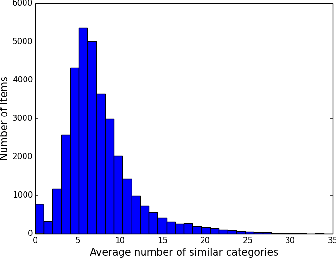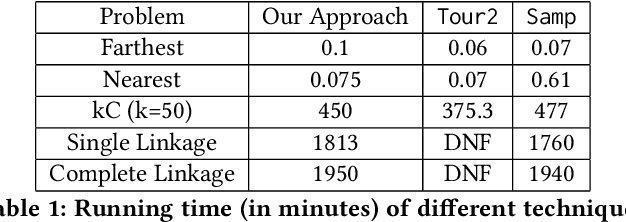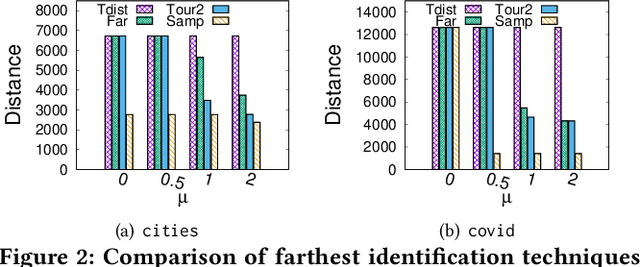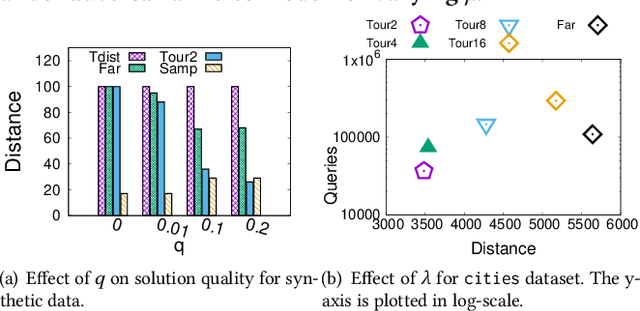Sainyam Galhotra
SIFOTL: A Principled, Statistically-Informed Fidelity-Optimization Method for Tabular Learning
Jul 23, 2025Abstract:Identifying the factors driving data shifts in tabular datasets is a significant challenge for analysis and decision support systems, especially those focusing on healthcare. Privacy rules restrict data access, and noise from complex processes hinders analysis. To address this challenge, we propose SIFOTL (Statistically-Informed Fidelity-Optimization Method for Tabular Learning) that (i) extracts privacy-compliant data summary statistics, (ii) employs twin XGBoost models to disentangle intervention signals from noise with assistance from LLMs, and (iii) merges XGBoost outputs via a Pareto-weighted decision tree to identify interpretable segments responsible for the shift. Unlike existing analyses which may ignore noise or require full data access for LLM-based analysis, SIFOTL addresses both challenges using only privacy-safe summary statistics. Demonstrating its real-world efficacy, for a MEPS panel dataset mimicking a new Medicare drug subsidy, SIFOTL achieves an F1 score of 0.85, substantially outperforming BigQuery Contribution Analysis (F1=0.46) and statistical tests (F1=0.20) in identifying the segment receiving the subsidy. Furthermore, across 18 diverse EHR datasets generated based on Synthea ABM, SIFOTL sustains F1 scores of 0.86-0.96 without noise and >= 0.75 even with injected observational noise, whereas baseline average F1 scores range from 0.19-0.67 under the same tests. SIFOTL, therefore, provides an interpretable, privacy-conscious workflow that is empirically robust to observational noise.
VERIRAG: Healthcare Claim Verification via Statistical Audit in Retrieval-Augmented Generation
Jul 23, 2025Abstract:Retrieval-augmented generation (RAG) systems are increasingly adopted in clinical decision support, yet they remain methodologically blind-they retrieve evidence but cannot vet its scientific quality. A paper claiming "Antioxidant proteins decreased after alloferon treatment" and a rigorous multi-laboratory replication study will be treated as equally credible, even if the former lacked scientific rigor or was even retracted. To address this challenge, we introduce VERIRAG, a framework that makes three notable contributions: (i) the Veritable, an 11-point checklist that evaluates each source for methodological rigor, including data integrity and statistical validity; (ii) a Hard-to-Vary (HV) Score, a quantitative aggregator that weights evidence by its quality and diversity; and (iii) a Dynamic Acceptance Threshold, which calibrates the required evidence based on how extraordinary a claim is. Across four datasets-comprising retracted, conflicting, comprehensive, and settled science corpora-the VERIRAG approach consistently outperforms all baselines, achieving absolute F1 scores ranging from 0.53 to 0.65, representing a 10 to 14 point improvement over the next-best method in each respective dataset. We will release all materials necessary for reproducing our results.
VeriMinder: Mitigating Analytical Vulnerabilities in NL2SQL
Jul 23, 2025Abstract:Application systems using natural language interfaces to databases (NLIDBs) have democratized data analysis. This positive development has also brought forth an urgent challenge to help users who might use these systems without a background in statistical analysis to formulate bias-free analytical questions. Although significant research has focused on text-to-SQL generation accuracy, addressing cognitive biases in analytical questions remains underexplored. We present VeriMinder, https://veriminder.ai, an interactive system for detecting and mitigating such analytical vulnerabilities. Our approach introduces three key innovations: (1) a contextual semantic mapping framework for biases relevant to specific analysis contexts (2) an analytical framework that operationalizes the Hard-to-Vary principle and guides users in systematic data analysis (3) an optimized LLM-powered system that generates high-quality, task-specific prompts using a structured process involving multiple candidates, critic feedback, and self-reflection. User testing confirms the merits of our approach. In direct user experience evaluation, 82.5% participants reported positively impacting the quality of the analysis. In comparative evaluation, VeriMinder scored significantly higher than alternative approaches, at least 20% better when considered for metrics of the analysis's concreteness, comprehensiveness, and accuracy. Our system, implemented as a web application, is set to help users avoid "wrong question" vulnerability during data analysis. VeriMinder code base with prompts, https://reproducibility.link/veriminder, is available as an MIT-licensed open-source software to facilitate further research and adoption within the community.
Intervention and Conditioning in Causal Bayesian Networks
May 23, 2024Abstract:Causal models are crucial for understanding complex systems and identifying causal relationships among variables. Even though causal models are extremely popular, conditional probability calculation of formulas involving interventions pose significant challenges. In case of Causal Bayesian Networks (CBNs), Pearl assumes autonomy of mechanisms that determine interventions to calculate a range of probabilities. We show that by making simple yet often realistic independence assumptions, it is possible to uniquely estimate the probability of an interventional formula (including the well-studied notions of probability of sufficiency and necessity). We discuss when these assumptions are appropriate. Importantly, in many cases of interest, when the assumptions are appropriate, these probability estimates can be evaluated using observational data, which carries immense significance in scenarios where conducting experiments is impractical or unfeasible.
A Data-Centric Online Market for Machine Learning: From Discovery to Pricing
Oct 27, 2023



Abstract:Data fuels machine learning (ML) - rich and high-quality training data is essential to the success of ML. However, to transform ML from the race among a few large corporations to an accessible technology that serves numerous normal users' data analysis requests, there still exist important challenges. One gap we observed is that many ML users can benefit from new data that other data owners possess, whereas these data owners sit on piles of data without knowing who can benefit from it. This gap creates the opportunity for building an online market that can automatically connect supply with demand. While online matching markets are prevalent (e.g., ride-hailing systems), designing a data-centric market for ML exhibits many unprecedented challenges. This paper develops new techniques to tackle two core challenges in designing such a market: (a) to efficiently match demand with supply, we design an algorithm to automatically discover useful data for any ML task from a pool of thousands of datasets, achieving high-quality matching between ML models and data; (b) to encourage market participation of ML users without much ML expertise, we design a new pricing mechanism for selling data-augmented ML models. Furthermore, our market is designed to be API-compatible with existing online ML markets like Vertex AI and Sagemaker, making it easy to use while providing better results due to joint data and model search. We envision that the synergy of our data and model discovery algorithm and pricing mechanism will be an important step towards building a new data-centric online market that serves ML users effectively.
METAM: Goal-Oriented Data Discovery
Apr 18, 2023Abstract:Data is a central component of machine learning and causal inference tasks. The availability of large amounts of data from sources such as open data repositories, data lakes and data marketplaces creates an opportunity to augment data and boost those tasks' performance. However, augmentation techniques rely on a user manually discovering and shortlisting useful candidate augmentations. Existing solutions do not leverage the synergy between discovery and augmentation, thus under exploiting data. In this paper, we introduce METAM, a novel goal-oriented framework that queries the downstream task with a candidate dataset, forming a feedback loop that automatically steers the discovery and augmentation process. To select candidates efficiently, METAM leverages properties of the: i) data, ii) utility function, and iii) solution set size. We show METAM's theoretical guarantees and demonstrate those empirically on a broad set of tasks. All in all, we demonstrate the promise of goal-oriented data discovery to modern data science applications.
A Vision for Semantically Enriched Data Science
Mar 02, 2023Abstract:The recent efforts in automation of machine learning or data science has achieved success in various tasks such as hyper-parameter optimization or model selection. However, key areas such as utilizing domain knowledge and data semantics are areas where we have seen little automation. Data Scientists have long leveraged common sense reasoning and domain knowledge to understand and enrich data for building predictive models. In this paper we discuss important shortcomings of current data science and machine learning solutions. We then envision how leveraging "semantic" understanding and reasoning on data in combination with novel tools for data science automation can help with consistent and explainable data augmentation and transformation. Additionally, we discuss how semantics can assist data scientists in a new manner by helping with challenges related to trust, bias, and explainability in machine learning. Semantic annotation can also help better explore and organize large data sources.
Crab: Learning Certifiably Fair Predictive Models in the Presence of Selection Bias
Dec 21, 2022Abstract:A recent explosion of research focuses on developing methods and tools for building fair predictive models. However, most of this work relies on the assumption that the training and testing data are representative of the target population on which the model will be deployed. However, real-world training data often suffer from selection bias and are not representative of the target population for many reasons, including the cost and feasibility of collecting and labeling data, historical discrimination, and individual biases. In this paper, we introduce a new framework for certifying and ensuring the fairness of predictive models trained on biased data. We take inspiration from query answering over incomplete and inconsistent databases to present and formalize the problem of consistent range approximation (CRA) of answers to queries about aggregate information for the target population. We aim to leverage background knowledge about the data collection process, biased data, and limited or no auxiliary data sources to compute a range of answers for aggregate queries over the target population that are consistent with available information. We then develop methods that use CRA of such aggregate queries to build predictive models that are certifiably fair on the target population even when no external information about that population is available during training. We evaluate our methods on real data and demonstrate improvements over state of the art. Significantly, we show that enforcing fairness using our methods can lead to predictive models that are not only fair, but more accurate on the target population.
Community Recovery in the Geometric Block Model
Jun 22, 2022



Abstract:To capture inherent geometric features of many community detection problems, we propose to use a new random graph model of communities that we call a \emph{Geometric Block Model}. The geometric block model builds on the \emph{random geometric graphs} (Gilbert, 1961), one of the basic models of random graphs for spatial networks, in the same way that the well-studied stochastic block model builds on the Erd\H{o}s-R\'{en}yi random graphs. It is also a natural extension of random community models inspired by the recent theoretical and practical advancements in community detection. To analyze the geometric block model, we first provide new connectivity results for \emph{random annulus graphs} which are generalizations of random geometric graphs. The connectivity properties of geometric graphs have been studied since their introduction, and analyzing them has been difficult due to correlated edge formation. We then use the connectivity results of random annulus graphs to provide necessary and sufficient conditions for efficient recovery of communities for the geometric block model. We show that a simple triangle-counting algorithm to detect communities in the geometric block model is near-optimal. For this we consider two regimes of graph density. In the regime where the average degree of the graph grows logarithmically with number of vertices, we show that our algorithm performs extremely well, both theoretically and practically. In contrast, the triangle-counting algorithm is far from being optimum for the stochastic block model in the logarithmic degree regime. We also look at the regime where the average degree of the graph grows linearly with the number of vertices $n$, and hence to store the graph one needs $\Theta(n^2)$ memory. We show that our algorithm needs to store only $O(n \log n)$ edges in this regime to recover the latent communities.
How to Design Robust Algorithms using Noisy Comparison Oracle
May 12, 2021



Abstract:Metric based comparison operations such as finding maximum, nearest and farthest neighbor are fundamental to studying various clustering techniques such as $k$-center clustering and agglomerative hierarchical clustering. These techniques crucially rely on accurate estimation of pairwise distance between records. However, computing exact features of the records, and their pairwise distances is often challenging, and sometimes not possible. We circumvent this challenge by leveraging weak supervision in the form of a comparison oracle that compares the relative distance between the queried points such as `Is point u closer to v or w closer to x?'. However, it is possible that some queries are easier to answer than others using a comparison oracle. We capture this by introducing two different noise models called adversarial and probabilistic noise. In this paper, we study various problems that include finding maximum, nearest/farthest neighbor search under these noise models. Building upon the techniques we develop for these comparison operations, we give robust algorithms for k-center clustering and agglomerative hierarchical clustering. We prove that our algorithms achieve good approximation guarantees with a high probability and analyze their query complexity. We evaluate the effectiveness and efficiency of our techniques empirically on various real-world datasets.
 Add to Chrome
Add to Chrome Add to Firefox
Add to Firefox Add to Edge
Add to Edge